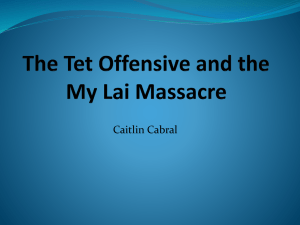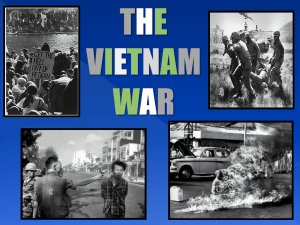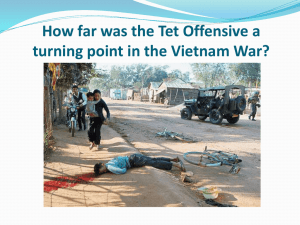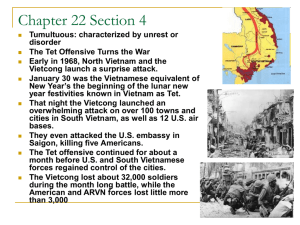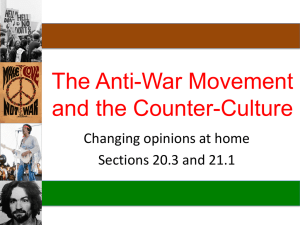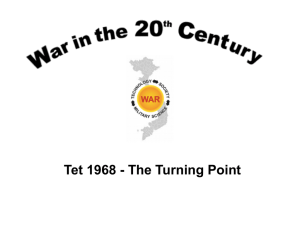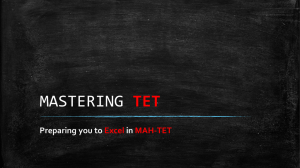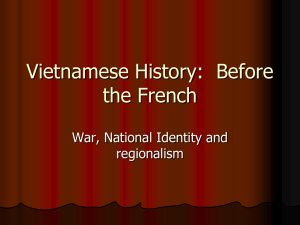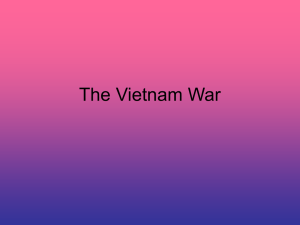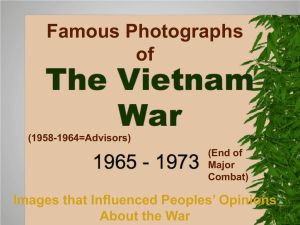Andrew`s Vietnam Era PPT
advertisement
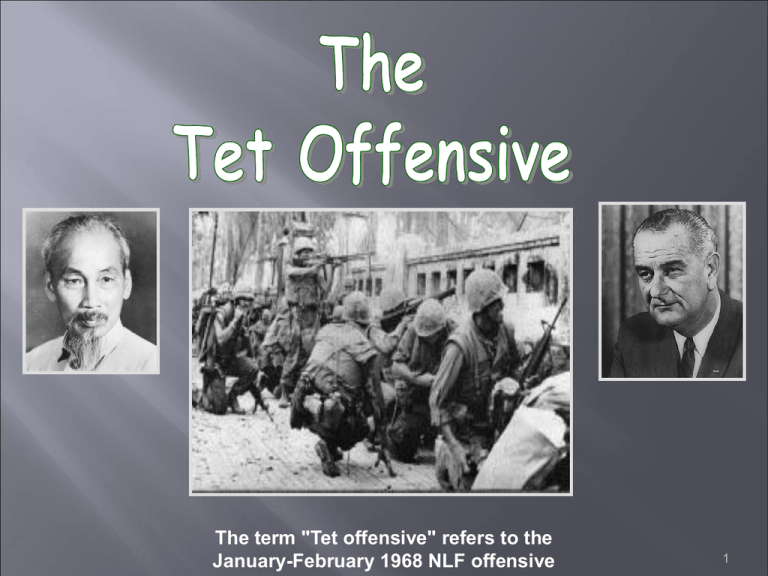
The term "Tet offensive" refers to the January-February 1968 NLF offensive 1 Part I The Military Battle 2 The Vietnam War was a military struggle fought in Vietnam from c. 1949 to 1975. It involved the North Vietnamese and the National Liberation Front (NLF) in conflict ,United States forces, other allies and the South Vietnamese army. 3 Vietnam was divided in half in 1954: North Communist South Democracy In 1965 the US and other allies sent in troops to prevent the South Vietnamese government from collapsing and turning all of Vietnam Communist. 4 Between 1965 and 1967, the US increased its military presence dramatically. This policy led to increased anti-war demonstrations in America. The US government claimed progress was being made. 500000 450000 400000 350000 300000 250000 200000 150000 100000 50000 0 US Troops 1965 1967 5 There was tension in Vietnam during the lead up to Tet. At Right a Monk in South Vietnam lights himself on fire to protest South Vietnamese government. 6 In November 1967 General Westmoreland spearheaded a public relations drive for the Johnson administration to bolster flagging public support. In a speech before the National Press Club he said that a point in the war had been reached, "where the end comes into view." 7 January 21, 1968 20,000 NVA troops under the command of Gen. Giap attack the American air base at Khe Sanh. A 77 day siege begins as 6000 U.S. Marines and ARVN troops in the isolated outpost are encircled. 8 US focus was on the siege of Khe Shahn. General Giap knew Americans were protesting war at home. Media attention was becoming key factor. Giap also wanted to start a people’s uprising in the South against the US. 9 Giap was aware of the growing US peace movement and of the deep divisions the war was causing in American society. What the General needed was a body-blow that would break Washington's will to carry on. Wanted a quick and decisive victory that would be well in time for the 1968 US Presidential campaign. 10 Tet is the most important and popular holiday and festival in Vietnam. It is the Vietnamese New Year which is based on the Lunar calendar. Usually a 3 day holiday; end of January. 11 Truce was declared so both sides of conflict could celebrate Tet with their families. NVA and Viet Cong began sneaking into cities with smuggled weapons. Used flower carts, rigged coffins and trucks supposedly filled with rice and vegetables. They were disguised as peasants, refugees and workers. 12 January 31, 1968 - 84,000 Viet Cong guerrillas aided by NVA troops launch the Tet Offensive attacking a hundred cities and towns throughout South Vietnam. They used the Tet truce agreement to aid the element of surprise. 13 January 31- March 7 35 NVA and Viet Cong battalions are defeated by 50 battalions of American and Allied troops that had been positioned to protect the city 14 January 31, 1968 19 VC commandos blew their way through the outer walls of the Embassy and overran the five MP's on duty. 2 MP's were killed as the VC tried to blast their way through the main Embassy doors with anti-tank rockets. 15 The VC failed and found themselves pinned-down by the Marine guards who kept the VC in an intense firefight. By mid-morning, the battle had turned. All 19 VC were killed, their bodies scattered around the Embassy courtyard. 16 January 31- March 2 12,000 NVA and Viet Cong troops storm the lightly defended historical city. South Vietnamese troops and three U.S. Marine battalions counter-attack and engage in the heaviest fighting of the entire Tet Offensive. 18 Over 3000 "enemies of the people" including South Vietnamese government officials, captured South Vietnamese officers, and Catholic priests were executed by the Viet Cong and NVA in Hue. 19 45000 40000 35000 30000 25000 Killed 20000 15000 10000 5000 0 US S. Vietnam NVA, VC Civilians 20 Giap’s plan had called for a quick victory. He was overextended, under supplied and without reinforcements. The quick win did not happen. ARVN forces stood their ground. Us Air power was crucial No uprising resulted 21 Much like the Vietnam war itself, deciding whether Tet was a success or a failure is very confusing! Either way, the Tet Offensive today is seen as the turning point of the war. 22 Part II The Propaganda Battle 23 The Tet Offensive was both a big public relations and psychological victory for the communists. There were several reasons Giap was able to claim success after the offensive. 24 The optimistic assessments made prior to the Tet offensive by the administration and the Pentagon came under heavy criticism The "credibility gap" that had opened in 1967 widened into a chasm. Many Americans did not believe LBJ or Gen. Westmoreland’s assessment of the war. 25 Parts of the Tet Offensive were captured on film. Many Americans saw first hand the assault on the US embassy in Saigon. Brought the war home for many. 26 "For it seems now more certain than ever," Cronkite said, "that the bloody experience of Vietnam is to end in a stalemate." After watching Cronkite's broadcast, LBJ was quoted as saying: "That's it. If I've lost Cronkite, I've lost middle America." Respected CBS Anchorman turns against the War in Vietnam 28 Starting with the Tet Offensive in January; 1968 became the bloodiest and costliest year for US troops in Vietnam. Losses in 1968 made the call to bring the troops home louder. 16000 14000 12000 10000 8000 6000 Killed in Action 4000 2000 0 1966 1968 1970 29 ALLIED STRENGTH: C. 1,000,000 Total Allied military casualties: Approximately 45,820 casualties: 9,078 killed 35,212 wounded 1,530 missing VC & NVA STRENGTH: 400,000-500,000 Total VC & NVA military casualties: Approximately 111,179 casualties: 44,842 killed 61,267 wounded 5,070 missing Civilian: 14,000 killed, 24,000 wounded 30 The Tet Offensive also helped unite those at home in their dissenting opinions of the war. The Anti-War movement really began to strengthen, especially during the election year of 1968. 31 The Tet Offensive importance lies in the fact that it broke the will of the American people to continue the fight and consequently, the American Government . Tet turned many people, especially the US media, against the Vietnam War. 32
